Nature Sightseeing
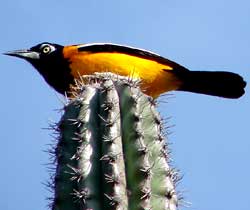 Although Aruba experiences a very dry climate generally, there are a few lush areas that are considered by local and migratory birds to be an oasis!
Although Aruba experiences a very dry climate generally, there are a few lush areas that are considered by local and migratory birds to be an oasis!A water treatment facility empties into two inter-connected man-made lakes, known as the large and small Bubali Bird Ponds. It is surrounded by a generous helping of lush vegetation and the area has become a resting and breeding area for more than 80 species of migratory birds.
Birds that inhabit the sanctuary include herons, egrets, gulls, skimmers, coots, cormorants, numerous species of ducks and more.
An observation tower has been erected to allow birdwatchers to get a true birds' eye view. Be sure to bring your binoculars and telephoto lens.
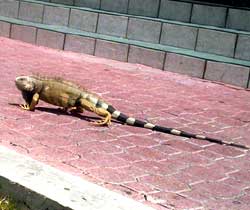 Aruba's dry, desert-like rocky terrain is an ideal home to many four-legged animals, most notably, the mountain goat. They are usually found near the rock formation of Ayo. While driving the countryside, you will come across wild donkeys and many green lizards, such as iguanas.
Aruba's dry, desert-like rocky terrain is an ideal home to many four-legged animals, most notably, the mountain goat. They are usually found near the rock formation of Ayo. While driving the countryside, you will come across wild donkeys and many green lizards, such as iguanas.For birdlovers, the four San Nicolas Bay Keys located at the southeastern part of Aruba are major nesting sites for different tern species: sooty terns, black noddies, and brown noddies nest in or under buttonwood trees.
Along the Bubali ponds in the northwest - a former salt-pan now an artificial freshwater wetland fed by the effluent of a waste-water treatment plant - buttonwood and white mangrove appear. Buttonwood growing along the Eastern shoreline of the larger lake, attracts brown pelicans and cormorants diving for food in the deep waters of this lake.
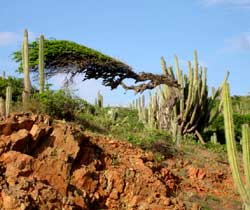 Aruba's favorite trademarks are inspired by the island's own natural vegetation. Rolling landscapes are robust with lush cacti, aloe and distinctively pointing divi divi trees.
Aruba's favorite trademarks are inspired by the island's own natural vegetation. Rolling landscapes are robust with lush cacti, aloe and distinctively pointing divi divi trees.The climate and flora are typically classified as desert - an exotic panorama when coupled with the shimmering turquoise seas that inhabit virtually every horizon. Natural vegetation is celebrated in the beautifully appointed Arikok National Park, where nature walking tours are available to view the wildlife in the area.
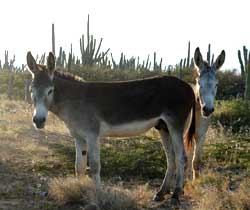 Maybe it's those big gentle eyes. Or the wacky grin and the ridiculous noise they make. Whatever it is, donkeys have a certain something that many people find completely endearing. The Aruba Donkey Sanctuary takes in injured and sick wild donkeys, providing care and a permanent home. This is a great place to spend a couple hours, especially if you're an animal lover or a kid (and if you're not either, that may have changed by the time you leave!). The donkeys love visitors, especially those with a handful of carrots or apples. Before you leave, stop by the little refreshment stand for a cold drink or a unique souvenir T-shirt.
Maybe it's those big gentle eyes. Or the wacky grin and the ridiculous noise they make. Whatever it is, donkeys have a certain something that many people find completely endearing. The Aruba Donkey Sanctuary takes in injured and sick wild donkeys, providing care and a permanent home. This is a great place to spend a couple hours, especially if you're an animal lover or a kid (and if you're not either, that may have changed by the time you leave!). The donkeys love visitors, especially those with a handful of carrots or apples. Before you leave, stop by the little refreshment stand for a cold drink or a unique souvenir T-shirt.Located near the Ayo rock formations, Aruba • 297-584-1063
http://www.arubandonkey.org/
Natural Wonders
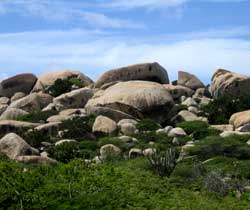 For such a flat sandy island, the presence of unusual mountains and huge monolithic boulders that dot the countryside are truly an enigma. These strange puzzling geological formations contain large quartzdiorite stone and provide adventure seekers with an "unexplained" mystery. They also provide good vantage points to view the island from a high elevation.
For such a flat sandy island, the presence of unusual mountains and huge monolithic boulders that dot the countryside are truly an enigma. These strange puzzling geological formations contain large quartzdiorite stone and provide adventure seekers with an "unexplained" mystery. They also provide good vantage points to view the island from a high elevation. Casibari Boulders
Just north of Hooiberg, another rock formation rises up from the desert soil. The boulders' freshly strewn appearance have created some unique scenery for the area. Some of the boulders weigh several tons and feature peculiar forms. The Government of Aruba has created walking trails and steps through the boulders, allowing hikers to reach the top to obtain breathtaking views of the island.
Ayo Rock Formations
It's often been described as the cartoon town of "Bedrock" seen in the animated TV show "The Flintstones." The stone formations at Ayo were once the dwelling place of an ancient race of people that left petroglyph markings on the stone boulders. The area is surrounded with huge stones that look as if they had been stacked on top of each other by giants. Scientists still have not been able to explain how these rocks got here. Modern pathways have been constructed to allow the visitor to explore this ancient site.
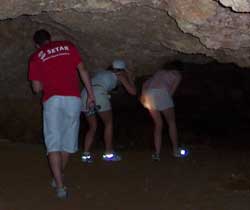 Colorful tales of pirates and buried treasure have a long tradition of being circulated by the locals of Aruba. The island's name of Aruba means "red gold" in Spanish, and exploring the caves along the southeast coast can be a swashbuckling experience in getting a feel for Aruba's golden history.
Colorful tales of pirates and buried treasure have a long tradition of being circulated by the locals of Aruba. The island's name of Aruba means "red gold" in Spanish, and exploring the caves along the southeast coast can be a swashbuckling experience in getting a feel for Aruba's golden history.Guadirikiri Cave
The Guadirikiri Cave is famous for its two chambers where sunlight shines through and is the perfect backdrop for unique pictures. Be adventurous and dare to go down the 100 foot long tunnel, home of hundreds of harmless bats. Although its exact history is not known with any certainty, caves like this one are said to have been the hiding places of pirates!
Fontein Cave
The Fontein Cave is the most popular of the caves as it is the only one that has the drawings of Arawak Indians on the ceilings, providing a real sense of island history to this cave.
Huliba Cave
The Huliba Cave is also known as the Tunnel of Love because of the heart shaped opening at its entrance. You will need flashlights to explore the 300 foot long passage way.
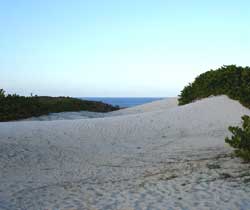 Aruba's desert landscape lends itself to trademark images of cacti, aloe and huge areas typified by gigantic hills of sand.
Aruba's desert landscape lends itself to trademark images of cacti, aloe and huge areas typified by gigantic hills of sand.Many people that are touring the island by jeep or scooter enjoy driving along the northeast coast shoreline to view the massive sand dunes. It is not permitted to drive on the sand dunes, but they can be explored on foot.
"California Dunes" at Hudishibana
Popularly named for the offshore wreck of the famous ship "California," the isolated northwestern tip of the island features some of the most spectacular scenery, with large rolling sand dunes and an old stone lighthouse.
More Wonders
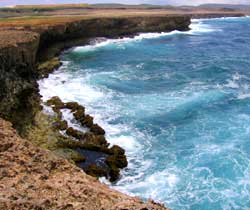 The Government of Aruba has dedicated approximately 18 percent of the island to this national park. It has many walking trails that are well kept and open to the public for exploring. Some tour companies offer guided tours through this massive protected area that is teeming with unusual plants and wildlife. The park is safe to explore if you stay on the main path. You may find some big green lizards but they are harmless like most of the other animals that inhabit the area.
The Government of Aruba has dedicated approximately 18 percent of the island to this national park. It has many walking trails that are well kept and open to the public for exploring. Some tour companies offer guided tours through this massive protected area that is teeming with unusual plants and wildlife. The park is safe to explore if you stay on the main path. You may find some big green lizards but they are harmless like most of the other animals that inhabit the area. It is located near Mt. Arikok, close the center of the island and is a natural preserve which features some of the oldest Arawak drawings, as well as trails that showcase Aruba's great variety of plants and animals like the divi-divi and kwihi trees, rare and exotic cacti, aloe, tropical flowers, birds and iguanas.
The government is very concerned about the environment and strives to maintain the park by employing only high quality, nature friendly and environmentally sound organizations to beautify the island for the Aruban community.
Arikok National Park was first designated as an area of significant national importance in the early 1980's. It is an area of unique scenic beauty, flora and fauna, geological formations and cultural resources. The highest points in Aruba are located in the park and include Arikok and Jamanota hilltops.
The Arikok National Park land area encompasses the three primary geological formations that shape the island of Aruba: the Aruba lava formation, a quartz diorite formation and a limestone formation extending inward from the coastline. These formations have played an important role, not only in supporting unique, indigenous plants and wildlife, but by influencing historic human settlement and activity patterns on the island.
The rock outcrops, boulders and crevices between the various formations create micro-climactic conditions that support unique examples of indigenous flora and fauna. As a result, the park is the habitat of several animal species found only in Aruba including two snake species: the cascabel, Crotalus thurissus uni- color (Aruba island's rattle - snake) and the santanero, Leptodira bakeri (Aruba cat-eyed snake); the kododo blauw, Cnemido- phorus arubensus (Aruban whiptail lizard); and two bird species: the shoco, Athene cunicu- laria arubensis (Aruban burrowing owl) and the prikichi, Aratinga pertinax arubensis (Aruban parakeet).
Early settlement and activity patterns of the island were also influenced by the resources and micro-climactic conditions found in this area. The limestone formation, for example, supports the largest natural fresh water spring on the island and, for that reason, was the site of early agricultural settlements and small-scale plantations during the early years of European rule. The micro-climactic conditions on the western side of the highest hilltops in the park, Arikok and Jamanota, provide protected locations from the constant northeasterly winds.
This, together with the better soil conditions in this area, made the western side of the island more suitable for agriculture and settlement. In the early days of European rule, the merchant and wealthier classes of farmers settled along Aruba's south coast near present day Oranjestad while poorer settlers and farm workers were relegated to areas with less fertile soils and difficult terrain, such as the Arikok National Park territory. The remains of several of their settlements can be found in this area and the form and shape of their houses, known as the cas di torta, have became a cultural icon for Arubans.
Several phases of Native American occupation occurred in Aruba, each leaving behind artifacts and evidence of the inhabitants' presence. Significant sites of early native art and settlements are located inside Arikok National Park. Many of these sites are threatened by unstable conditions and uncontrolled visitation.
Geological conditions also resulted in the presence of gold deposits in the Arikok area. During the last century, a considerable amount of mining activity occurred, leaving behind remnants of these early operations including the ruins of a mine complex known as Miralamar.
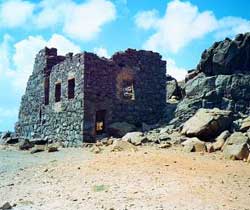 In the 1400's and 1500's, adventurers traveled throughout the Caribbean in search of wealth and treasures. According to legend, one of these treasure islands was named "Oro Ruba," which means "red gold." Now known as Aruba, a colorful history of gold prospectors has shaped the island's history. Today, remnants of this history can still be visited.
In the 1400's and 1500's, adventurers traveled throughout the Caribbean in search of wealth and treasures. According to legend, one of these treasure islands was named "Oro Ruba," which means "red gold." Now known as Aruba, a colorful history of gold prospectors has shaped the island's history. Today, remnants of this history can still be visited. Bushiribana
On the northern coast, midway down the island, lie the abandoned gold mines that were the center of Aruba's gold rush during the nineteenth century. In 1824, gold was finally discovered in Aruba, and eventually, the industry produced more than 3 million pounds of gold.
Balashi
While driving down to Pos Chiquito, along the southwest shores, take a left and drive through historic Frenchman's Pass, a narrow canyon in the rocks with hundreds of chattering parakeets and birds in residence.
Nearby is the Balashi gold mill ruins at the tip of the Spanish Lagoon, which is nearby the world's second-largest water desalination plant.
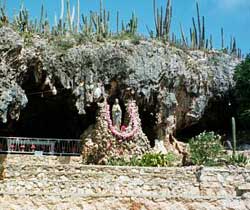 The population of Aruba is predominantly Catholic, a fact that can be seen by observing the number of Catholic churches located in all of the districts of the island. On a drive to the northeastern coast from San Nicolas, you'll drive by a unique Roman Catholic shrine built into the rocks.
The population of Aruba is predominantly Catholic, a fact that can be seen by observing the number of Catholic churches located in all of the districts of the island. On a drive to the northeastern coast from San Nicolas, you'll drive by a unique Roman Catholic shrine built into the rocks. The Lourdes Grotto was created under the guidance of a priest named "Erkamp" and parishioners in the year 1958. The grotto is located in Seroe Pretoe (black hill). The year 1958 was an important year as it was 150 years ago that the Holy Virgin appeared in front of Bernadette, as legend has it in Aruba.
Bishop Holterman blessed the statue from the Holy Virgin and Bernadette. The statue weighed 700 kilos and one Mrs. Maria Geerman played an important role in the development of the grotto. Eight people were needed to hoist the statue and place it in the grotto.
Mrs. Geerman's wish was to be buried in the same box that carried the Holy Virgin and this wish was granted. Elmar, the electrical company of Aruba, provided a permanent light pole so that the statue would be illuminated throughout the night.
Every year, on February 11th (feast of Lady of Lourdes) a procession leaves from the St. Theresita church in San Nicolas to the grotto, where a mass is performed.
Location: Seroe Pretoe (black hill) San Nicolas
